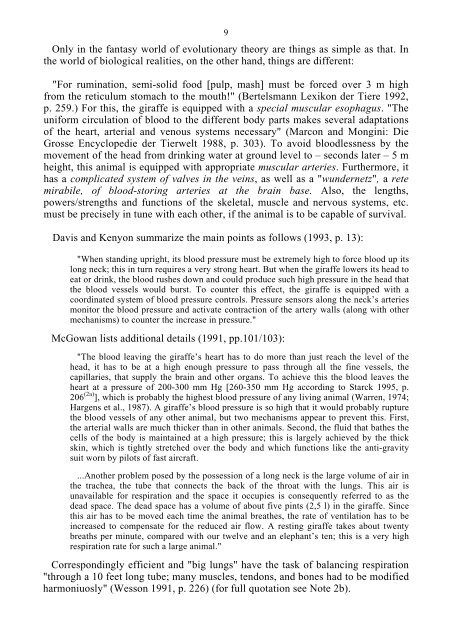The Evolution of the Long-Necked Giraffe (pdf) - Wolf-Ekkehard Lönnig
The Evolution of the Long-Necked Giraffe (pdf) - Wolf-Ekkehard Lönnig
The Evolution of the Long-Necked Giraffe (pdf) - Wolf-Ekkehard Lönnig
Create successful ePaper yourself
Turn your PDF publications into a flip-book with our unique Google optimized e-Paper software.
9<br />
Only in <strong>the</strong> fantasy world <strong>of</strong> evolutionary <strong>the</strong>ory are things as simple as that. In<br />
<strong>the</strong> world <strong>of</strong> biological realities, on <strong>the</strong> o<strong>the</strong>r hand, things are different:<br />
"For rumination, semi-solid food [pulp, mash] must be forced over 3 m high<br />
from <strong>the</strong> reticulum stomach to <strong>the</strong> mouth!" (Bertelsmann Lexikon der Tiere 1992,<br />
p. 259.) For this, <strong>the</strong> giraffe is equipped with a special muscular esophagus. "<strong>The</strong><br />
uniform circulation <strong>of</strong> blood to <strong>the</strong> different body parts makes several adaptations<br />
<strong>of</strong> <strong>the</strong> heart, arterial and venous systems necessary" (Marcon and Mongini: Die<br />
Grosse Encyclopedie der Tierwelt 1988, p. 303). To avoid bloodlessness by <strong>the</strong><br />
movement <strong>of</strong> <strong>the</strong> head from drinking water at ground level to – seconds later – 5 m<br />
height, this animal is equipped with appropriate muscular arteries. Fur<strong>the</strong>rmore, it<br />
has a complicated system <strong>of</strong> valves in <strong>the</strong> veins, as well as a "wundernetz", a rete<br />
mirabile, <strong>of</strong> blood-storing arteries at <strong>the</strong> brain base. Also, <strong>the</strong> lengths,<br />
powers/strengths and functions <strong>of</strong> <strong>the</strong> skeletal, muscle and nervous systems, etc.<br />
must be precisely in tune with each o<strong>the</strong>r, if <strong>the</strong> animal is to be capable <strong>of</strong> survival.<br />
Davis and Kenyon summarize <strong>the</strong> main points as follows (1993, p. 13):<br />
"When standing upright, its blood pressure must be extremely high to force blood up its<br />
long neck; this in turn requires a very strong heart. But when <strong>the</strong> giraffe lowers its head to<br />
eat or drink, <strong>the</strong> blood rushes down and could produce such high pressure in <strong>the</strong> head that<br />
<strong>the</strong> blood vessels would burst. To counter this effect, <strong>the</strong> giraffe is equipped with a<br />
coordinated system <strong>of</strong> blood pressure controls. Pressure sensors along <strong>the</strong> neck’s arteries<br />
monitor <strong>the</strong> blood pressure and activate contraction <strong>of</strong> <strong>the</strong> artery walls (along with o<strong>the</strong>r<br />
mechanisms) to counter <strong>the</strong> increase in pressure."<br />
McGowan lists additional details (1991, pp.101/103):<br />
"<strong>The</strong> blood leaving <strong>the</strong> giraffe’s heart has to do more than just reach <strong>the</strong> level <strong>of</strong> <strong>the</strong><br />
head, it has to be at a high enough pressure to pass through all <strong>the</strong> fine vessels, <strong>the</strong><br />
capillaries, that supply <strong>the</strong> brain and o<strong>the</strong>r organs. To achieve this <strong>the</strong> blood leaves <strong>the</strong><br />
heart at a pressure <strong>of</strong> 200-300 mm Hg [260-350 mm Hg according to Starck 1995, p.<br />
206 (2a) ], which is probably <strong>the</strong> highest blood pressure <strong>of</strong> any living animal (Warren, 1974;<br />
Hargens et al., 1987). A giraffe’s blood pressure is so high that it would probably rupture<br />
<strong>the</strong> blood vessels <strong>of</strong> any o<strong>the</strong>r animal, but two mechanisms appear to prevent this. First,<br />
<strong>the</strong> arterial walls are much thicker than in o<strong>the</strong>r animals. Second, <strong>the</strong> fluid that ba<strong>the</strong>s <strong>the</strong><br />
cells <strong>of</strong> <strong>the</strong> body is maintained at a high pressure; this is largely achieved by <strong>the</strong> thick<br />
skin, which is tightly stretched over <strong>the</strong> body and which functions like <strong>the</strong> anti-gravity<br />
suit worn by pilots <strong>of</strong> fast aircraft.<br />
...Ano<strong>the</strong>r problem posed by <strong>the</strong> possession <strong>of</strong> a long neck is <strong>the</strong> large volume <strong>of</strong> air in<br />
<strong>the</strong> trachea, <strong>the</strong> tube that connects <strong>the</strong> back <strong>of</strong> <strong>the</strong> throat with <strong>the</strong> lungs. This air is<br />
unavailable for respiration and <strong>the</strong> space it occupies is consequently referred to as <strong>the</strong><br />
dead space. <strong>The</strong> dead space has a volume <strong>of</strong> about five pints (2,5 l) in <strong>the</strong> giraffe. Since<br />
this air has to be moved each time <strong>the</strong> animal brea<strong>the</strong>s, <strong>the</strong> rate <strong>of</strong> ventilation has to be<br />
increased to compensate for <strong>the</strong> reduced air flow. A resting giraffe takes about twenty<br />
breaths per minute, compared with our twelve and an elephant’s ten; this is a very high<br />
respiration rate for such a large animal."<br />
Correspondingly efficient and "big lungs" have <strong>the</strong> task <strong>of</strong> balancing respiration<br />
"through a 10 feet long tube; many muscles, tendons, and bones had to be modified<br />
harmoniuosly" (Wesson 1991, p. 226) (for full quotation see Note 2b).














